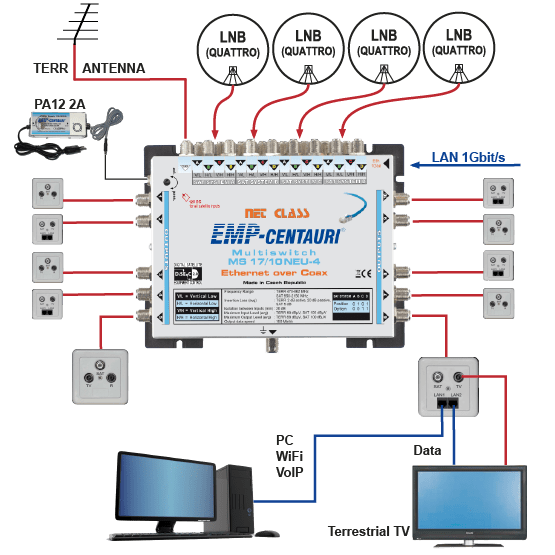Ethernet over Coax
The coaxial cable is a suitable transfer medium not only for TV signals but also for data transmissions.
History – early years of Data Networks
In the first stage of computer network development, the coaxial cable was used as a shared medium for all connected computers. Data sent from one computer was distributed by common cable to all other computers. Each of them therefore “listened” to all communication and had to choose only what was addressed to him. Data collisions must also have been solved, when two or more computers have begun transmitting data at the same time, resulting in unusable mixture of signals in the shared media. The resulting network throughput could not achieve theoretically possible 10 Mbit/s.
Present – star topology and UTP cables
Contemporary small-scale metal networks differ in two ways: star topology and twisted pair metallic cables. Shared media technology has been abandoned, data traffic between any end devices goes through network nodes that are created by the so-called ethernet switches. These devices “map” their network and forward the data only to the intended recipient. As a result, cables do not carry redundant data and no collisions occur. The speed of these networks is close to 100 Mbit/s. The second shift is use of twisted pairs instead of a coaxial cable. Although UTP cables contain 8 twisted pairs, they are usually thinner and more flexible than coaxial cables. On the other hand, the termination of the UTP cable with the RJ45 connector requires special pliers.

Ethernet over coax technology
While the benefit of the star topology of the data network is obvious, the advantage of the UTP cable over the coaxial is questionable. Virtually achievable speeds are similar, higher bandwidth of the coaxial cable permits more universal use – not only for data but also for the classic connection of TV and radio receivers. Installing the UTP cable is easier thanks to its better bending radius, on the other hand, the F-connector can be mounted on the coaxial without special tools. At present, it is possible to build a local data network in a star topology but with coaxial cables. EMP-Centauri offers both nodes (Ethernet switches with coaxial ports) and coaxial/UTP converters for this system. With its 100 Mbit/s transmission rate, the EMP-Centauri EoC technology is a full-featured alternative to the Fast Ethernet UTP standard. In addition to universal data transmission (PC, SmartTV, VoIP, IP cameras, …), classical reception of terrestrial and satellite TV signals is still possible.

Wiring example: (cables: red coax, blue utp)

